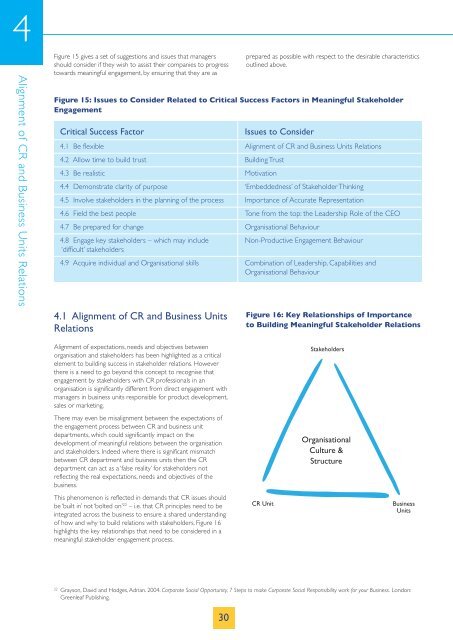Stakeholder Engagement - Cranfield School of Management ...
Stakeholder Engagement - Cranfield School of Management ...
Stakeholder Engagement - Cranfield School of Management ...
You also want an ePaper? Increase the reach of your titles
YUMPU automatically turns print PDFs into web optimized ePapers that Google loves.
4<br />
Alignment <strong>of</strong> CR and Business Units Relations<br />
Figure 15 gives a set <strong>of</strong> suggestions and issues that managers<br />
should consider if they wish to assist their companies to progress<br />
towards meaningful engagement, by ensuring that they are as<br />
Figure 15: Issues to Consider Related to Critical Success Factors in Meaningful <strong>Stakeholder</strong><br />
<strong>Engagement</strong><br />
Critical Success Factor Issues to Consider<br />
4.1 Be flexible Alignment <strong>of</strong> CR and Business Units Relations<br />
4.2 Allow time to build trust Building Trust<br />
4.3 Be realistic Motivation<br />
4.4 Demonstrate clarity <strong>of</strong> purpose ‘Embeddedness’ <strong>of</strong> <strong>Stakeholder</strong> Thinking<br />
4.5 Involve stakeholders in the planning <strong>of</strong> the process Importance <strong>of</strong> Accurate Representation<br />
4.6 Field the best people Tone from the top: the Leadership Role <strong>of</strong> the CEO<br />
4.7 Be prepared for change Organisational Behaviour<br />
4.8 Engage key stakeholders – which may include<br />
‘difficult’ stakeholders<br />
Non-Productive <strong>Engagement</strong> Behaviour<br />
4.9 Acquire individual and Organisational skills Combination <strong>of</strong> Leadership, Capabilities and<br />
Organisational Behaviour<br />
4.1 Alignment <strong>of</strong> CR and Business Units<br />
Relations<br />
Alignment <strong>of</strong> expectations, needs and objectives between<br />
organisation and stakeholders has been highlighted as a critical<br />
element to building success in stakeholder relations. However<br />
there is a need to go beyond this concept to recognise that<br />
engagement by stakeholders with CR pr<strong>of</strong>essionals in an<br />
organisation is significantly different from direct engagement with<br />
managers in business units responsible for product development,<br />
sales or marketing.<br />
There may even be misalignment between the expectations <strong>of</strong><br />
the engagement process between CR and business unit<br />
departments, which could significantly impact on the<br />
development <strong>of</strong> meaningful relations between the organisation<br />
and stakeholders. Indeed where there is significant mismatch<br />
between CR department and business units then the CR<br />
department can act as a ‘false reality’ for stakeholders not<br />
reflecting the real expectations, needs and objectives <strong>of</strong> the<br />
business.<br />
This phenomenon is reflected in demands that CR issues should<br />
be ‘built in’ not ‘bolted on’ 22 – i.e. that CR principles need to be<br />
integrated across the business to ensure a shared understanding<br />
<strong>of</strong> how and why to build relations with stakeholders. Figure 16<br />
highlights the key relationships that need to be considered in a<br />
meaningful stakeholder engagement process.<br />
30<br />
prepared as possible with respect to the desirable characteristics<br />
outlined above.<br />
Figure 16: Key Relationships <strong>of</strong> Importance<br />
to Building Meaningful <strong>Stakeholder</strong> Relations<br />
CR Unit<br />
<strong>Stakeholder</strong>s<br />
Organisational<br />
Culture &<br />
Structure<br />
Business<br />
Units<br />
22 Grayson, David and Hodges, Adrian. 2004. Corporate Social Opportunity, 7 Steps to make Corporate Social Responsibility work for your Business. London:<br />
Greenleaf Publishing.
















